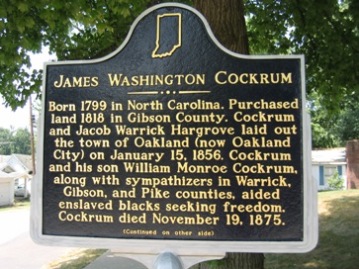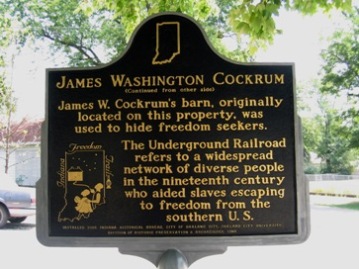James Washington Cockrum


Location: 411 W. Oak St., Oakland City. (Gibson County, Indiana)
Installed: 2005 Indiana Historical Bureau, City of Oakland City, Oakland City University, Division of Historic Preservation & Archaeology, IDNR
ID# : 26.2005.1
Text
Side one:
Born 1799 in North Carolina. Purchased land 1818 in Gibson County. Cockrum and Jacob Warrick Hargrove laid out the town of Oakland (now Oakland City) on January 15, 1856. Cockrum and his son William Monroe Cockrum, along with sympathizers in Warrick, Gibson, and Pike counties, aided enslaved blacks seeking freedom. Cockrum died November 19, 1875.
Side two:
James W. Cockrum's barn, originally located on this property, was used to hide freedom seekers. The Underground Railroad refers to a widespread network of diverse people in the nineteenth century who aided slaves escaping to freedom from the southern U.S.
Keywords
Underground Railroad, African American
Annotated Text
Born 1799 in North Carolina.(1) Purchased land 1818 in Gibson County.(2) Cockrum and Jacob Warrick Hargrove laid out the town of Oakland (now Oakland City) on January 15, 1856.(3) Cockrum and his son William Monroe Cockrum, along with sympathizers in Warrick, Gibson, and Pike counties, aided enslaved blacks seeking freedom.(4) Cockrum died November 19, 1875.(5)
James W. Cockrum's barn, originally located on this property, was used to hide freedom seekers.(6) The Underground Railroad refers to a widespread network of diverse people in the nineteenth century who aided slaves escaping to freedom from the southern U.S.
Notes:
1. List of Dead, Oakland City Baptist Church, Gibson County, Indiana, compiled by Ella C. (Cockrum's granddaughter) Wheatley), available in Genealogy Division, Indiana State Library; Transcript, Cockrum Family Bible, Dubois County Indiana Family and Church Records, Genealogical Society of Utah, 1986, microfilm, available in Genealogy Division, Indiana State Library.
2.Margaret Ruth Waters, Indiana Land Entries, 2 vols. (Indianapolis, 1948-1949), 1(?):61.
3.Plat of Oakland, January 15, 1856, Gibson County Deed Record, Vol. R, December 1855-November 1856, pp. 284-285.
4.William M. Cockrum, History of the Underground Railroad. . . reprint (New York, 1969), pp. 75-97. See Chapter IX review, attached, for example of activity.
5. His wife, Judah died five days later. Transcript, Cockrum Family Bible, Dubois County Indiana Family and Church Records, Genealogical Society of Utah, 1986, microfilm, available in Genealogy Division, Indiana State Library; c. 2004 photograph of James Washington Cockrum tombstone located at Baptist Cemetery, Oakland City, Indiana; List of Dead, Oakland City Baptist Church, Gibson County, Indiana, compiled by Ella C. (Cockrum's granddaughter) Wheatley), available in Genealogy Division, Indiana State Library.
6. Cockrum, Chapter IX review, attached, see Statement 4.
* All U. S. Census data has been retrieved from Ancestry.com or Heritagequest accessed at the Indiana State Library.
NOTE: Fergus Bordewich highlights the work of James Cockrum and his son William Cockrum in Bound for Glory: The Underground Railroad and the War for the Soul of America (New York: 2005). In an interview published in the Journal for the Liberal Arts & Sciences, Oakland City University, Vol. 8, No., 3, p. 47, Bordewich stated: "I found Cockrum's book absolutely fascinating as an eye-witness description of how the Underground Railroad operated in one locality. It is not a scholarly work by any measure. . . . But as a memoir, I think it is pretty credible. That is, I believe Cockrum can generally be trusted when he is describing people he knew personally, events he participated in, and conversations that he was a part of, with the caveat that Cockrum was only a teenager at the time, and wrote down his recollections some fifty years after the fact."
REVIEW OF CHAPTER IX ("Crazy Jeff Lewis") BY HISTORICAL BUREAU
William M. Cockrum, History of the Underground Railroad. . . reprint (New York, 1969), pp. 75-97. This book was originally published in 1915 by J. W. Cockrum Printing Co., Indiana.
The Indiana Historical Bureau has conducted a limited search for the persons named in this chapter as a review of the reliability of Cockrum's work. The numbered statements are from Cockrum. According to Cockrum, p. 92, these events took place circa 1853.
1. Cockrum : Jeff Lewis was black slave working as manager or overseer for his master on a tobacco farm in northwest Kentucky. (p. 75)
2. Cockrum : Lewis and seven fugitives met guards who piloted fleeing blacks across Ohio River where they hid in a cornfield until they could safely go about 10 miles to Ira Caswell's. (p. 80) In U.S. Federal Census, 1850 and 1860, Ira Caswell was listed in Hart Township, Warrick County, Indiana. 3. Cockrum : Later that night, three guards, seven fugitives, and Mr. Caswell went into Mr. (George) Hill's cornfield. (p. 81) In U.S. Federal Census, 1850, George Hill was listed in Patoka Township, Gibson County, Indiana; U. S. Federal Census, 1860, George Hill was listed in Greer Township, Warrick County, Indiana.
4. Cockrum : At daylight, George Hill came to James Cockrum's door (William's father) to let him know that seven fugitives and two guards were in Cockrum's barn cellar, and one guard was in the loft keeping watch. Cockrum farm was on land now occupied by Oakland City (pp. 81-82). Cockrum barn was located somewhere on lots 9, 10, 11, and 12 in Block 6 of Southern Enlargement, Oakland City, Indiana. William Cockrum stated (p. 71) that barn was located on land where office and garage owned by Dr. George C. Mason stood. Deed of Property, Alexander H. Polk and B. H. Polk to George C. Mason, June 10, 1879, Lots 9, 10, 11, 12 in No. 6, Southern Enlargement, Oakland City, Indiana. According to applicant's transfer of property summary, Mason sold these lots in 1932. Polk purchased these lots in 1873 from James W. Cockrum. Map, Oakland, An Atlas of Gibson and Pike Counties, Indiana (Philadelphia, 1881), 43. Map indicates buildings on Lot 12. Sanborn Map, Oakland City, 1907, microfilm, available Indiana Division, Indiana State Library. Map shows buildings, including doctor's office, on Lots 10, 11, 12.
5. Cockrum : Cockrum sent notice to Dr. John Posey in Pike County and Basil Simpson who lived in Pike County near the Dongola bridge.(p. 82). In U.S. Federal Census, 1860, John W. Posey was listed in Petersburg, Pike County, Indiana. In the1850 census, Posey is also listed, but ages and birthplaces do not agree. Household does agree. In U.S. Federal Census, 1860, Bazil Simpson was listed in Logan Township, Pike County, Indiana.
6. Cockrum : On the way north, William Cockrum and party found John Stuckey about 2 miles south of Petersburg; fugitives would cross river one mile east of Wright's ferry (p. 84). In U.S. Federal Census, 1850, John Stuckey, age 32, was listed in Petersburg, Pike County, Indiana.
7. Cockrum : Stuckey warned party that several "negro hunters" were at Jack Kinman's hotel in Petersburg (p. 84). In U.S. Federal Census, 1850, Jackson Kinman, born in Georgia in 1820 was listed in Petersburg, Pike County, Indiana.
8. Cockrum : Jeff Lewis planned to get himself and his wife away to Canada. His wife was owned by man living near Uniontown, Kentucky (p. 85).
9. Cockrum : Lewis met his wife, three other fugitives, and three guards. They were on the north bank of the Ohio River by midnight. They followed the same route —Caswell to Hill to Cockrum's barn cellar (pp. 88-89).
10. Cockrum : Later that day, J. J. Kirkman, sheriff or deputy sheriff of Gibson County came to dinner at Cockrum's. He saw one of the three "colored" boys left with Cockrum until they could be sent to Liberia. In U.S. Federal Census, 1850, Joseph J. Kirkman was listed in Princeton, Gibson County, Indiana. The three boys were sons of Jacob Stephenson a free black man from South Carolina who lived in Columbia Township, Gibson County, Indiana until November 1853 when he and his family emigrated to Liberia. Cockrum, pp. 242-43; U. S. Federal Census, 1850; Coy D. Robbins, compiler, Indiana Negro Registers 1852-1865; "Indiana Emigrants to Liberia, " The Indiana Historian (Indianapolis, March 2000), 16.
11. Cockrum : Jeff Lewis, his wife, and the 3 other fugitives continued north following the same route as previously mentioned (p. 92).
12. Cockrum : In fall of 1864, William Cockrum was commanding the military prison at Nashville, Tennessee. One of the Union soldiers to be committed to the prison for an infraction was recognized by Cockrum to be Jeff Lewis, "Co., I, 17 U.S. Colored Troops" (pp. 92-97). A Jefferson Lewis is listed as member of 117th Regiment, US Colored Infantry organized at Covington, Ky., July 18, 1864; a Jefferson Lewis is also listed as a member of the 5th Regiment US Colored Cavalry organized at Camp Nelson, Ky., October 24, 1864. Civil War Soldiers and Sailors System, National Park System accessed July 1, 2004. The 17th Regiment Infantry, U.S. Colored Troops was organized at Nashville, Tenn., December 12 - 21, 1863. Attached to Post of Murfreesboro, Tenn., Dept. of the Cumberland, to April, 1864; Post and District of Nashville, Tenn., Dept. of the Cumberland, to December, 1864; 1st Colored Brigade, District of the Etowah, Dept. of the Cumberland, to January, 1865; Post and District of Nashville, Tenn., Dept. of the Cumberland, to April, 1866. SERVICE.--Duty at McMinnville and Murfreesboro, Tenn., until November, 1864; Battle of Nashville, Tenn., December 15-16; Overton Hill December 16; Pursuit of Hood to the Tennessee River, December 17-27; Decatur, December 28-30; Duty at Post of Nashville, Tenn., and in the Dept. of Tennessee until April, 1866. Mustered out April 25, 1866. civilwararchive.com, accessed November 3, 2004. The preceding information could put Jeff Lewis and William Cockrum in Nashville Tennessee at the same time, assuming there is an error above re the 117th Regiment. More research needs to be done.
